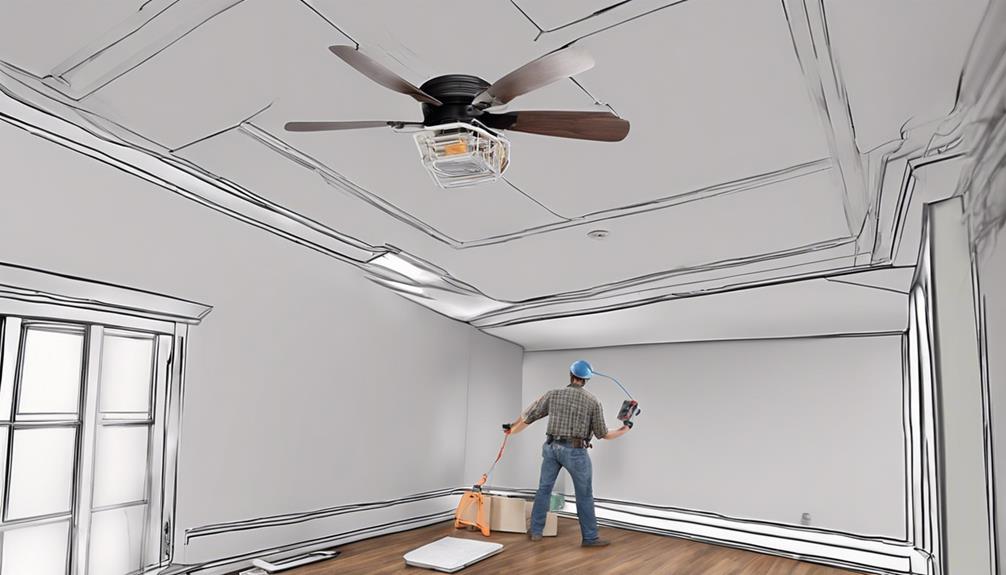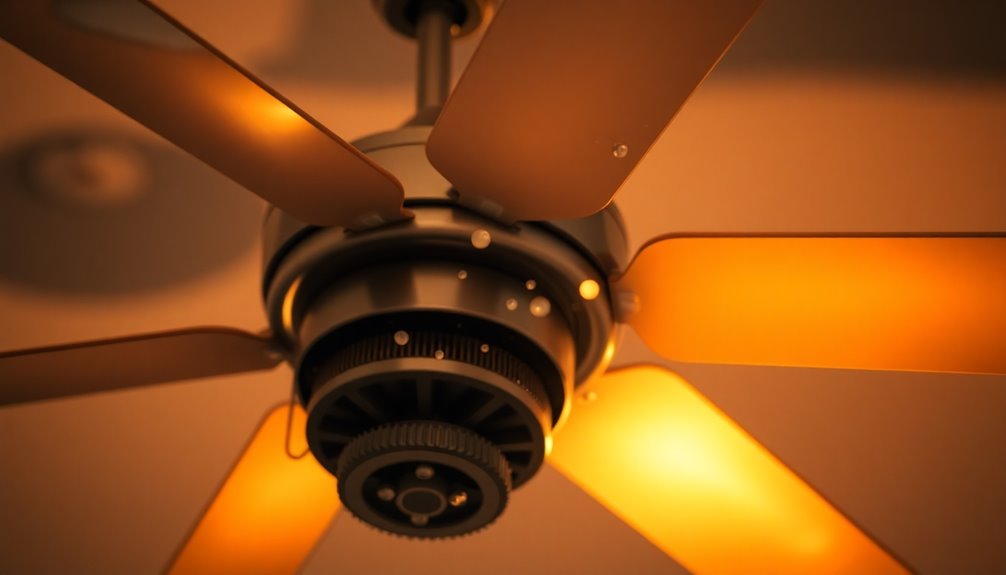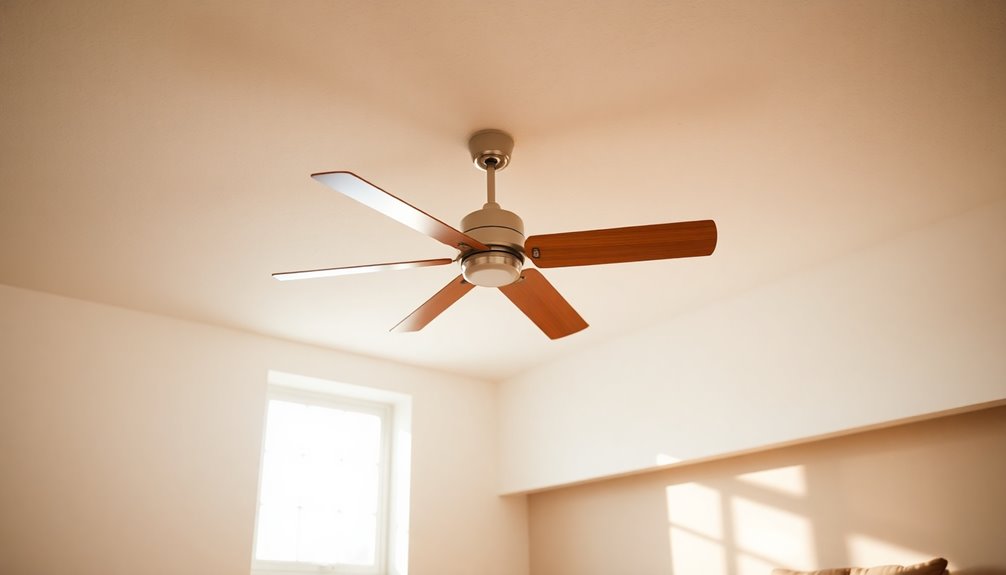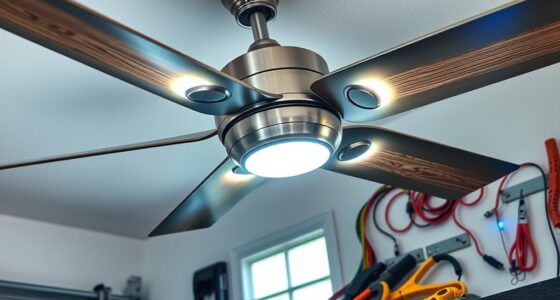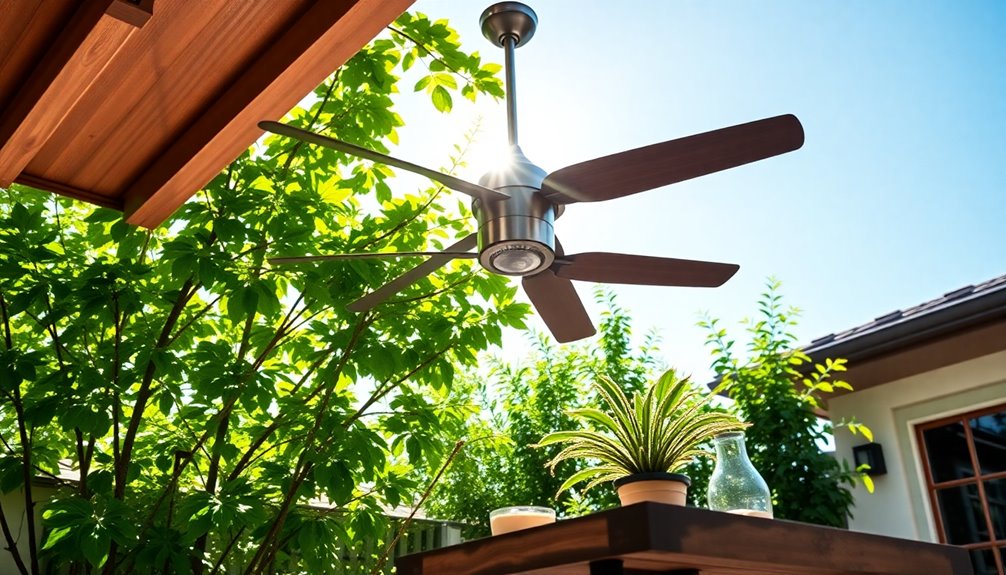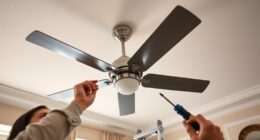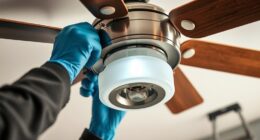To install a ceiling fan without existing wiring in seven simple steps, start by turning off electricity at the circuit breaker to avoid accidents. Next, carefully decide the fan's location based on support joists' strength and proximity to electrical sources. Ensure safe placement by measuring distances and assessing weight considerations. Prepare the electrical wiring by locating a spot near a power source, using a stud finder for mounting, and checking wiring lengths. Install an electrical box securely by nailing it to a support joist, using a brace for added stability, and cutting a precise hole for a snug fit. Plan the wiring route meticulously, gather necessary tools, and make secure connections ensuring insulation. Mount the ceiling fan by following manufacturer instructions, balancing it, and firmly tightening all screws and bolts. Connect the wires correctly, insulate them with electrical tape, ground green or bare copper wires, and securely attach fan blades. Remember regular maintenance for optimal performance.
Ensuring safety and efficiency is key, but there's more to learn to master this task successfully.
Key Takeaways
- Determine ideal location near power source.
- Ensure proper support for fan weight.
- Use stud finder for secure mounting.
- Plan wiring route for efficiency.
- Securely attach fan blades for stability.
Turn Off Electricity
Before beginning the installation process, it's essential to turn off the electricity to ensure safety and prevent any accidents. When installing a ceiling fan, cutting off power by flipping the circuit breaker is crucial. This step not only eliminates the risk of electrocution but also makes working with wiring much safer.
By ensuring the power is off, you create a secure environment to handle the installation without any potential hazards. Never attempt to work on wiring while the circuit is active to avoid accidents and ensure a smooth installation process. Remember, safety should always come first when dealing with electrical components.
Determine Fan Location

When determining the ideal location for your ceiling fan, it's crucial to consider factors like support joists' strength and proximity to existing electrical sources for efficient wiring.
Measure distances from walls and fixtures to ensure proper placement and safe operation.
Avoid areas with obstacles that could hinder the fan's performance for a smooth installation process.
Fan Placement Considerations
To ensure the ceiling fan is securely positioned and safe for operation, evaluating the support joists and considering the fan's weight are crucial steps in determining its optimal location.
Checking the support joists in the ceiling is essential to prevent safety risks and ensure proper attachment of the fan.
By carefully choosing a location based on the weight of the ceiling fan, you can avoid potential ceiling damage and ensure proper support for safe operation.
Proper fan placement not only enhances air circulation efficiency but also maximizes the fan's effectiveness in cooling the room.
Taking these fan placement considerations into account will help you install your ceiling fan in a way that's both functional and safe for use.
Electrical Wiring Assessment
Considering the support joists and weight of the ceiling fan, it's important to assess the electrical wiring situation to determine the optimal location for installation.
- Check support joists in the ceiling to ensure they can bear the weight of the fan.
- Locate a spot where you can install the fan that's close to an existing power source.
- Consider using a stud finder to locate the best spot for mounting the fan.
- Determine the optimal placement for the fan to ensure proper airflow in the room.
- Assess the distance from the nearest power source to determine the length of wiring needed for installation.
Install Electrical Box
For stability and safety during installation, nail the electrical box to a support joist. Ensuring the electrical box is securely mounted is crucial for the overall safety and stability of your ceiling fan. If needed, use a brace and saddle to provide additional support for the electrical box. Cutting a precise hole in the ceiling to accommodate the box is essential for a secure fit. Make sure to follow instructions carefully when securing the brace to prevent any potential movement or instability. By preparing the area properly for wiring, you set the stage for a smooth and efficient installation process.
| Electrical Box Installation | |
|---|---|
| Nail box to support joist | Use a brace if needed |
| Cut precise hole in ceiling | Secure brace properly |
| Ensure stability and safety | Prepare area for wiring |
Taking these steps will help guarantee a successful installation of your ceiling fan without existing wiring.
Run Wiring to Fan

I'll guide you through the process of running wiring to your ceiling fan.
Plan the route for the wiring, gather the necessary tools, and take safety precautions to ensure a smooth installation.
Let's make sure the wiring is secure and properly insulated for a reliable and safe electrical setup.
Wiring Route Planning
To ensure a safe and efficient installation of the new ceiling fan:
Carefully plan the wiring route for running the wiring to the fan. Consider using fish tape to pull the wiring through walls and ceilings to connect the switch to the fan.
Properly connect the wiring to ensure the fan functions correctly and safely. Choose and install a wall switch in a convenient location for controlling the ceiling fan.
Following manufacturer guidelines for wiring and installation is crucial for the proper functioning of the ceiling fan. Planning the wiring route meticulously will help streamline the installation process and ensure a successful outcome for your new ceiling fan.
Tools for Wiring
When running wiring to the fan, it's essential to have the necessary tools for the installation process. You'll need a wire stripper to remove insulation from wires for proper connection.
A nail set and hammer may be required to secure the wiring in place. Additionally, a drill/driver is essential for creating holes in walls or ceilings for the wiring to pass through.
A drywall saw can be used to make precise cuts for running the wiring to the fan. These tools will help you successfully route the wiring to the fan's location and connect it to the ceiling plate securely for a safe and effective installation.
Safety Precautions
For ensuring safety while running wiring to the fan, it's important to use fish tape efficiently for pulling the wiring through walls and ceilings. When dealing with electrical components, safety should always be the top priority. Here are some key safety precautions to keep in mind:
- Ensure all connections are secure to prevent electrical hazards.
- Make sure the wiring is run in a safe and organized manner.
- Connect the wall switch to the fan to ensure proper operation.
- Follow the manufacturer's guidelines for wiring, passing wires through its center.
- Double-check that the wiring is done correctly to prevent any potential issues down the line.
Mount Ceiling Fan

Securing the ceiling fan to the electrical box is crucial for ensuring stability and safety. Before mounting the fan blades, make sure to use the provided mounting hardware and follow the manufacturer's instructions carefully for proper installation. This will help ensure that your fan is securely attached and functions correctly.
Checking that the fan is balanced and level is also important to prevent any wobbling or noise during operation. Tighten all screws and bolts securely to avoid any potential hazards once the fan is mounted.
After mounting the fan blades and securing the unit, it's essential to test the ceiling fan's function to ensure it operates smoothly and efficiently. This step will help you identify any issues early on and make any necessary adjustments before regular use.
Connect Wires

I connect the black wire from the ceiling fan to the black wire from the electrical box using a wire connector. Then, I proceed to connect the white wire from the ceiling fan to the white wire from the electrical box, ensuring a secure connection with a wire connector. Next, I join the green or bare copper wire from the ceiling fan to the corresponding wire from the electrical box for grounding purposes.
Here are some essential steps to follow during this wiring process:
- Secure Connections: Make sure all wires are securely fastened to avoid any loose connections that could lead to electrical issues.
- Insulate with Electrical Tape: It's crucial to insulate all connections with electrical tape to prevent any exposed wires that could pose a safety risk.
- Grounding: Ensure the green or bare copper wires are properly connected for grounding to maintain electrical safety.
- Follow Manufacturer's Instructions: Always refer to the manufacturer's instructions to guarantee the correct wiring connections for your specific ceiling fan model.
- Double-Check: Before proceeding, double-check all connections to ensure they're properly made before moving on to the next installation step.
Attach Fan Blades

After securely connecting the wires, the next step is attaching the fan blades to the fan motor using the provided screws. Fan blades play a crucial role in the efficiency and aesthetics of your ceiling fan. It's important to follow the manufacturer's instructions carefully to ensure proper installation. Here is a table highlighting key points about fan blades:
| Fan Blades | Importance |
|---|---|
| Sets of 3, 4, or 5 | Varies based on manufacturer and design |
| Secure Attachment | Prevents wobbling during operation |
| Balanced Alignment | Ensures smooth and efficient airflow |
| Varying Efficiency | Different blades impact airflow and appearance |
| Regular Maintenance | Clean blades for optimal performance and longevity |
Frequently Asked Questions
How Much Does It Cost to Install a Ceiling Fan Without Existing Wires?
When comparing costs for installing a ceiling fan without existing wires, factors like the fan type and installation complexity play a role. Basic models are more budget-friendly, while high-end options can be pricier.
It's essential to consider both the fan purchase and installation expenses. Despite varying installation costs, the long-term energy savings and comfort benefits make a ceiling fan a valuable investment.
Can You Connect the Red and Black Wire Together on a Ceiling Fan?
Yes, connecting the red and black wires together on a ceiling fan can cause a short circuit or damage. The red wire usually controls the fan's light kit, while the black wire handles the fan motor. It's crucial to adhere to the manufacturer's wiring instructions for safety and proper functionality.
Mixing up these wire colors might lead to the fan not working correctly or the light failing to turn on. Consulting an electrician can help avoid issues during installation.
How Do You Wire a Ceiling Fan Without a Switch?
When wiring a ceiling fan without a switch, consider wireless control options for convenience. Utilize a remote control, wireless wall switch, pull chain switch, or fan speed controller for fan operation.
Battery-operated wall switches or smart switches are easy alternatives. By exploring these wireless solutions, you can efficiently manage your ceiling fan without the need for traditional wiring.
Can You Hang a Ceiling Fan Without a Box?
Yes, hanging a ceiling fan without a box isn't recommended due to safety concerns. A box provides support and protection for the fan's wiring, ensuring proper grounding and preventing electrical hazards.
It's essential to use the correct type of electrical box for ceiling fan installation. Not using a box can lead to safety risks and may not meet building codes or manufacturer requirements.
It's best to prioritize safety when installing a ceiling fan.
Can I Still Install a Ceiling Fan Without Existing Wiring If I Have a Blue Wire?
Yes, you can still install a ceiling fan without existing wiring if you have a blue wire. Decoding the blue wire in this situation typically means it is a common wire used for a specific purpose, such as controlling the light on the fan separately from the fan itself.
Conclusion
In just 7 easy steps, you can install a ceiling fan without existing wiring.
Remember to turn off the electricity before starting and follow each step carefully for a safe installation.
By taking the time to do it right, you'll enjoy a cool breeze in no time.
So go ahead, tackle this project with confidence and upgrade your space with a stylish new ceiling fan!
